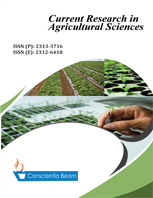Assessments of Market Oriented Beef Cattle Fattening System Under Farmer Management Condition in South OmO Zone of Snnpr
DOI:
https://doi.org/10.18488/journal.68/2016.3.3/68.3.31.45Abstract
A sample survey was conducted in six districts of three woreda in South Omo zone of SNNPR to assess smallholder beef cattle fattening and marketing systems under farmer management condition. Using a purposive sampling technique, a total of 120 households from six districts were included in the survey. The sample respondents indicated that about 97.5% were castrate their animals for fattening purpose while only 2.5% didn't. About 25.6% of the sample respondents had experience in fattening of uncastrated animals while 74.4% had not experienced in fattening uncastrated animal. About 90.6% of the fattening system they carry out was outdoors,5.1% was indoor and 4.3% were both indoor and outdoor. About 78.9% of the sample respondents indicated that the establishment of farmers' cooperative organization could help to exploit the existing livestock potential in a better way while 21.1% didn't think. About 77.9% Of the respondents indicated that although individual farmer tells the selling price for their own product, they were unable to sell at their own selling price. This is because market price setting for the product was by trader ,15.9% was by negotiation,2.7% was by farmer individually,1.8% respondents determined prices through involvement of brokers/middlemen-this offers the lowest profit margin for the producer due to the fee paid to the middle men and 0.9% was by both broker and negotiation. According to sample respondents, the majority of individual farmer didn’t set the price for their own product, they were price takers. Cattle marketing in the study area function at two levels, namely village level and primary markets. Market actors were producers, consumers, middlemen, restaurant owners, traders and butchers. The channels of cattle marketing was farmers-to-farmers, farmers-to-consumers, farmers-to-traders and farmers-to-butchers. Most of the feed resources were locally available Therefore, to increase the quality and number of animals fattened, providing farmers with sufficient training and extension services on improved cattle fattening technologies, adaptation and introduction of improved feeds and feeding system, market information are needed. Season and market locations were found to affect price of cattle suggesting the need to plan cattle fattening targeting season and market location to benefit farmers from better price, so that cattle fattening become sustainable.

